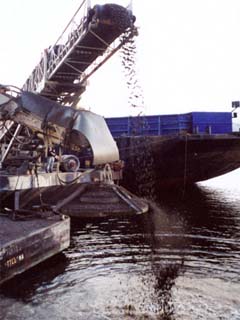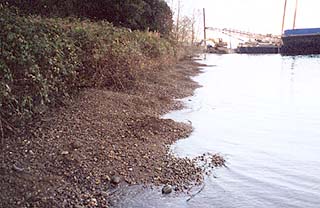
Surveys
DJC.COM
July 25, 2002
Salmon in the city: Seattle restores fish habitat
City of Seattle

Photos courtesy of the city of Seattle A machine nicknamed the “salad shooter” was used to disperse gravel along the Seward Park shoreline to create habitat for chinook salmon. |
Imagine the odyssey a young salmon experiences on its way through Seattle.
Most juvenile salmon journey to the ocean in a river. They find safety from their predators in the river’s shallow areas. They eat food that has dropped into the water from vegetation overhanging the river’s banks. And the river’s currents carry them along to their ocean destination miles away.
This enviable existence is not available to the young salmon swimming through the highly altered waterways of Seattle.
Imagine, for example, that you were a chinook salmon born in the Cedar River. Your route to the ocean takes you through Lake Washington, Lake Union and the Ship Canal, where there are no river currents to help you on your way. At your tiny size (1-3 inches), you must swim more than 20 miles to reach your destination.
To make matters worse, most of the shorelines you swim along have bulkheads or rip rap, so you find few shallow areas where you can rest, eat and hide. Predators like small mouthed bass lurk everywhere. It will take you take two to three months to reach Puget Sound — if you survive!
Now imagine you are a young salmon recently born in the Green River. On your way to the ocean, you must swim through the industrial heartland of Seattle: the Duwamish Waterway. Unlike your Cedar River relatives, you have river currents that can help your trip. But the “hardened” shores of the Duwamish provide almost no shallow water where you can rest and hide from predators. And since there is little overhanging vegetation on the river’s banks, just finding food can be tough.
To survive and reach the ocean, juvenile salmon need pockets of high-quality habitat in Seattle. Creating enough good habitat to stop and even reverse the declines in salmon runs will take many hands on deck. Government agencies, shoreline businesses and local neighborhood groups can all contribute.
Getting better
The good news is that knowledge about how to restore habitat in Seattle is growing every year. In 1999, when chinook were first listed as a “threatened” species under the Endangered Species Act, there were more questions than answers about the behavior of the fish in this urban environment. How big are they when they reach the city? How much time do they spend here? What is their survival rate? What kind of habitat do they need here?
But recent studies sponsored by the city of Seattle, the Army Corps of Engineers and King County are shedding light on these mysteries. Using the knowledge gained from this research as a guide, the city, businesses and citizens groups have begun working together to transform developed urban shorelines into safe havens for wild chinook.
Seward Park offered one opportunity to put new research findings into practice. Scientists have discovered that juvenile salmon swimming through Lake Washington need shallow, gradually sloping habitat with a sandy or gravelly lake bottom. They congregate in these areas to feed and hide from predators. Unfortunately, much of the shoreline of Lake Washington features bulkheads and rip rap which reduce this kind of habitat.
At Seward, the Seattle Parks Department, Seattle Public Utilities and the Army Corps of Engineers saw a chance to implement a pilot project that would add more shallow habitat with gravel to the southern shoreline of the lake, where young juveniles are especially vulnerable to predation.
Enter the mystery machine pictured with this story.
Affectionately referred to as the “salad shooter” by the project crew, this machine was specially designed to disperse gravel in the water along the edge of Seward Park, covering up larger rocks that attract predators of chinook like small mouthed bass.
In just one day, the salad shooter laid down 2,000 tons of fine gravel along the southern shore of the park, in two distinct sizes. Scientists will monitor the area to find out whether the larger or the smaller gravel does a better job of attracting chinook, so that future projects can be designed with the benefit of this new knowledge.
Business gets involved

The salad shooter placed about 2,000 tons of gravel in one day at Seward Park. |
The Duwamish Waterway presents a different challenge. With little public land along its channel, the success of habitat restoration here is especially dependent on private businesses and the Port of Seattle. In this area so important to the economy of Seattle, a number of businesses have shown what can be done to improve habitat for salmon while also meeting business goals.
Just this year, while in the process of repairing one of its docks, Olympic Tug & Barge enhanced salmon habitat along its shoreline in the East Duwamish Waterway. The company removed debris from under the dock, creating a more fish-friendly intertidal area.
Olympic also used a dock design with a grated deck to let more light through to the water. Scientists have discovered that juvenile fish often avoid dark areas under over-water structures like docks and piers. When they swim out into deeper water to avoid docks, they are more vulnerable to predation.
Community groups have also spearheaded projects to create better salmon habitat and attractive places for community residents.
Groundswell NW, a Ballard-based community group, is leading a partnership effort, which includes the Cascade Land Conservancy and the city of Seattle, to acquire and restore an essential piece of salmon habitat just downstream from the Ballard Locks.
Salmon undergo physiological changes as they move from fresh water rivers to the salt water of the ocean. In a natural estuary there is a large zone where salt and fresh water mixes, and where salmon can adjust slowly to new conditions. The locks, in contrast, create a more abrupt transition from salt to fresh water. High-quality habitat is needed just below the locks, where the much smaller transition zone can be found.
Private property owners also have a role to play in helping make our waterways more salmon friendly. By planting native vegetation at the water’s edge, or replacing bulkheads with “softer” approaches to control erosion that leaves more shallow water intact, property owners can help juvenile salmon on their way to the ocean.
Protecting salmon habitat in the middle of a city can seem like a daunting task. Some may wonder, why are we focusing resources here? Some may ask, shouldn’t we focus our resources where salmon are laying their eggs and hatching their young?
Investing in the protection of more habitat in upper watersheds is critical, but without good salmon habitat in Seattle, juveniles will never reach the ocean. Salmon rely on the city just as we do. As we create more and more pockets of restored shoreline, we will demonstrate that wild species can coexist with urban residents.
For more information about the city’s work to recover healthy populations of chinook salmon, and about what you can do to help, visit www.cityofseattle.net/salmon.
Kristin H. Anderson works on public outreach for the city of Seattle’s Salmon Recovery Team. She is also employed at Norton-Arnold & Co., a Seattle facilitation and public involvement consulting firm.Sarah McKearnan is a policy advisor to the city’s Salmon Recovery Team. She works in the director’s office at Seattle Public Utilities.
Other Stories:
- Water storage goes underground
- Getting back to basics with LEED
- Seattle LEEDs the nation in sustainable building
- New stormwater rules looming for contractors
- An incubator for cutting-edge power projects
- Linking up with the environment
- Designers find new life for old cardboard tubes
- EPA turns up the heat with temperature rules
- AGC teams with WSDOT for environment’s sake
- A wholistic look at engineering
- Toxic black mold — the next asbestos?
- Mold: Getting a grip on the fuzzy stuff
- A trail of mining waste turns into a trail of recreation
- No more fuming at chemistry class
- A battery of energy information
- New brownfields law comes with big changes
- ‘Green infrastructure’ puts Seattle on the map
- Detention ponds – all it takes is a little magic
- Ground zero for groundwater
- A pearl of a project on Oyster Creek
- BetterBricks program stacks up energy savings
- Shopping ‘green’
- Home Depot builds atop an old Oregon landfill
- Making clean water the green way
- A funny thing happened on the way to the dump
- Reducing energy costs, post crisis
- Managing stormwater in Pierce County
- Does best available science work for all buffers?
Copyright ©2009 Seattle Daily Journal and DJC.COM.
Comments? Questions? Contact us.